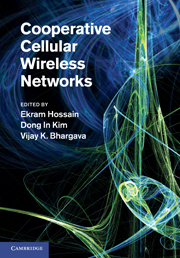Book contents
- Frontmatter
- Contents
- List of contributors
- Preface
- Part I Introduction
- Part II Cooperative base station techniques
- Part III Relay-based cooperative cellular wireless networks
- 6 Distributed space-time block codes
- 7 Collaborative relaying in downlink cellular systems
- 8 Radio resource optimization in cooperative cellular wireless networks
- 9 Adaptive resource allocation in cooperative cellular networks
- 10 Cross-layer scheduling design for cooperative wireless two-way relay networks
- 11 Green communications in cellular networks with fixed relay nodes
- 12 Network coding in relay-based networks
- Part IV Game theoretic models for cooperative cellular wireless networks
- Part V Standardization activities
- Index
11 - Green communications in cellular networks with fixed relay nodes
from Part III - Relay-based cooperative cellular wireless networks
Published online by Cambridge University Press: 03 May 2011
- Frontmatter
- Contents
- List of contributors
- Preface
- Part I Introduction
- Part II Cooperative base station techniques
- Part III Relay-based cooperative cellular wireless networks
- 6 Distributed space-time block codes
- 7 Collaborative relaying in downlink cellular systems
- 8 Radio resource optimization in cooperative cellular wireless networks
- 9 Adaptive resource allocation in cooperative cellular networks
- 10 Cross-layer scheduling design for cooperative wireless two-way relay networks
- 11 Green communications in cellular networks with fixed relay nodes
- 12 Network coding in relay-based networks
- Part IV Game theoretic models for cooperative cellular wireless networks
- Part V Standardization activities
- Index
Summary
Introduction
Mobile communication systems have to provide exponentially increasing data rates for an increasing number of subscribers using ubiquitous data services. As the capacity per cell is limited by the available bandwidth, the same time frequency resources must be spatially reused. Hence, the more the user density increases, the higher the spatial reuse must be to satisfy the demand for high data rate services. This chapter discusses relaying as a candidate technology to increase the spatial reuse and therefore to provide the required data rates while reducing energy consumption in mobile communication systems.
Two motivating examples
A challenging property as well as an opportunity for exploiting the wireless channel is nonlinear signal attenuation (path-loss), which offers the possibility to concentrate power at certain points in the network and spatially reuse resources within a mobile communication network. Consider an additive white Gaussian noise (AWGN) channel with a path-loss exponent α = 4, receiver noise power N, and transmission power P. Given these qualities and assuming a downlink transmission where a terminal can use the received signals from each radio access point (RAP), the observed signal-to-noise ratio (SNR) at a normalized distance d is given by ρ(d) = Σi P/N · |di − d|−α, where di is the position of the ith RAP.
- Type
- Chapter
- Information
- Cooperative Cellular Wireless Networks , pp. 300 - 323Publisher: Cambridge University PressPrint publication year: 2011
- 11
- Cited by



